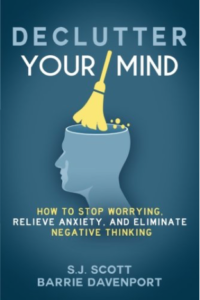A True Story about the Healing Power of Inertia
I’m 18 years old and it’s the day after I’ve had major surgery. If you’ve never had surgery it might surprise you to know that in most cases, they get patients up within 24 hours after an operation. People who get moving have fewer complications and get better faster. The only problem is, because I had to undergo several pre-op tests, I’ve had nothing to eat for at least 5 days. I’m in a lot of pain and I’m extremely weak.
Get up and walk? Are they serious? All I want to do is lie still and rest.
The nurse walks into my room, cranks up the back of my hospital bed and insists that I sit up. I want to cooperate but my muscles don’t. Even though I struggle with everything I’ve got, it seems like my back is super-glued to the sheet which is now soaked with the sweat of my exertion.
The nurse and I are both frustrated. But she is kind and finally gives me an assist, pulling me forward and helping me swing my legs over the side of the bed. She lifts me up onto my feet and…
I faint.
I’m not that big but 130 pounds of dead weight is more than she can handle. I’m vaguely aware as she collects my gangly arms and legs and dumps me back into bed.
Every 3-4 hours we try again. Every time I stand up, I faint. It doesn’t help that they give me a pain shot beforehand so I’ll be able to cope with the excruciating pain of my still-fresh incision. Each time we try I feel even weaker. Every fiber of my being just wants to stay horizontal.
By the next afternoon I still haven’t been able to pry my own back away from the hospital bed – let alone take a walk down the hall, which is our ultimate goal. The nurse is afraid if she drops me I could get injured but she’s not a quitter. As she tucks my exhausted body back into bed she mutters, “I have an idea.”
Later that evening she waltzes into my room accompanied by her “idea” – a strapping young resident from another floor named Dr. Valentine. He’s about 6’5″ and looks more like an NFL linebacker than your stereotypical doctor. He’s kind but stern. There is no way I’m not getting out of that bed and taking a walk down the hall with him. He’s all business. His strength is comforting and a little bit scary.
Before I know it he lifts me up into a standing position. As usual the black snow fills my vision and I begin to faint. But Dr. Valentine doesn’t let go. He calmly holds me against his chest until I stabilize. It takes a few minutes but finally my head clears. The next thing I know Dr. Valentine is puppet-walking me out the door and into the hall. I feel like Raggedy Ann but with his help I go through the motions. Then it’s back to bed. I’m exhausted – more weary than I’ve ever felt in my life.
Here’s the surprise: the next morning I’m able to get up on my own!
This time I can actually sit up and get out of bed. I don’t faint and and I’m able to walk down the hall on the arm of my very proud nurse. It still hurts, but each time it gets easier. By the next day, I’m able to get up and walk whenever I want… on my own. And I just kept walking back to a normal healthy life. (Thank you Dr. Valentine wherever you are!)
The Law of Inertia
Most people know that inertia is the force that keeps things stuck. As the law of physics states, “Inertia is the tendency for a body at rest to stay at rest.”
But that’s only half of the story.
The Law of Inertia actually says that things tend to keep doing what they are doing – unless some outside force intervenes. While it’s true that something that isn’t moving will tend to stay that way, that’s only half of the law. The other half says, “A body in motion will tend to stay in motion.”
The Tipping Point
The moment an outside force changes non-movement to movement – or vice versa – is a “tipping point.” That day in the hospital, Dr. Valentine was my tipping point. He was the “outside force” that got me moving again. From that point on it was easier because inertia now was working in my favor to help me keep moving.
How to Create a Tipping Point to Leverage the Power of Inertia
A few years ago I decided to start taking early morning hikes several days a week. I had a lot of trouble getting out the door. I was out of shape and as much as I focused on how good for my health daily walking and hiking would be, my attempts to get started were sporadic at best.
As a coach I know that it takes 21 days to “install” a habit. Finally I made a deal with myself to take a walk every day for a few weeks. Not Monday, Wednesday and Friday. Every day. To keep track I put a big “W” on my wall calendar each day I’ve kept that promise to myself.
I know it sounds silly but after a few days I didn’t want to break the zig-zag chain of W’s on my calendar. Even if I got busy and hadn’t yet walked, I’d sneak in a quick 5-minute stroll in the evening so I could earn my W and not break the chain. I liked watching the pattern grow.
My tipping point was a seemingly silly compulsion to keep the WWWWW chain unbroken!
After about 3 weeks I didn’t have to use the calendar trick any more. Soon I wasn’t just walking, I was hiking nearly every day. The Power of Inertia had taken over and movement was now my new pattern. The calendar trick helped tip the Law of Inertia to my side. Those 5 minute evening walks helped too. Why? Because if something is moving, it will tend to keep moving.
Behold the Power of Inertia!
If you want to change something in your life, and it feels overwhelming, it helps to remember that a tipping point can be a very small change. You can leverage the Power of Inertia if you are willing to go through a small bit of discomfort. Then it will get easier.
How can you leverage the Power of Inertia in your own life? What small force of change can you bring into play as your tipping point between being stuck and movement forward?
Please comment below.
Photo Credit
Related Posts:
The Power of Trim Tabs – How Small Changes Create Big Results



